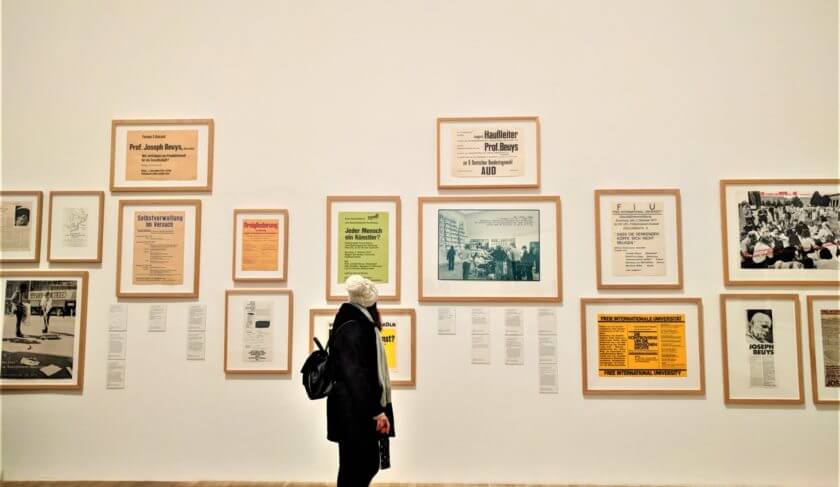
Live auctions can be one of the most exciting aspects of the art world. The auction room is filled with collectors, art spectators, as well as employees from the auction house, all of whom are there to bid on works of art — that can potentially go for millions of dollars. In many cases, the art is brought out with art handlers in white gloves and is shown to the audience, and the general mood is electric as the auctioneer calls out the bids… But what really happens at a live auction? And how do major artworks get priced? Here’s a rundown.
What happens at an auction?
One of the major misconceptions about art auctions is that it is a private event. This couldn’t be farther from the truth. Live auctions are open to the public; there are only some instances in which a ticket is required for entry, and if an event is ticketed, often you just need to contact the auction house directly to secure a ticket. And in the days before the main event, the works are often on view for the public — auction houses will install and display the artwork that will later be on the auction block. This is known in the industry as the “presale exhibit,” which gives potential bidders a chance to see the works in person ahead of time.
The Big Numbers
In 2020, according to the Art Market Report, public auction sales reached $17.6 billion. Last month alone, major auction houses Christie’s, Sotheby’s, and Phillips (located in New York City and London) broke record sales with several pieces sold on their auction blocks. Dubbed the “Marquee Sales Week,” these sales smashed previous records for artists such as Frida Kahlo, Banksy, and others. For example, Sotheby’s marquee week totaled $1.33 billion, while Christie’s sales added up to $1.1 billion.
But you don’t have to be a millionaire to invest. In other words, those big numbers can be misleading — many auction houses have affordable pieces on offer throughout the year, for just a few thousand dollars each. You can also invest in a share or a portion of a work of art, via companies like Yieldstreet and Masterworks. (But you can’t do that at auction — that happens behind the scenes. For now, we’ll talk about the bidding world for those looking to go all in.)
How Can You Bid On Items?
To bid on an item either in-person or online, you must first pre-register with the auction house. This can usually be done the day-of or some auction houses have you do it during their preview period.
Once you are registered you will be given a paddle that can be used during the auction. (You also must be of legal age to be able to participate in the bidding process of an auction.) While a live auction can be so much fun (and you should try to go if you can!) If you’re not able to make it, you can often do phone bidding, live online bidding, or absentee bidding which lets you put a bid in with the auctioneer before the auction.
How Auction Prices Are Determined
All items at an auction first must be valued by the auction house. All items will need to be verified and appraised to ensure that they are authentic and priced ethically and according to industry standards. There are a lot of factors that go into coming up with the estimated value such as the quality of the artwork, the subject matter, how rare it is, how successful previous auction sales have been, and their popularity in the market overall.
It’s important to keep in mind that each piece of art is unique, and so are the circumstances surrounding the sale. Once this process is completed, the estimated value of a work will be given.
Research The Item You’re Looking To Bid On
Before you ever consider a bid, check out the catalog. This is a booklet that’s available both online and in print which contains a wealth of information about the history of the work, the price, and even previous owners. Most auction houses also have art advisors who can assist you with the process, and answer any questions you may have along the way. You should also try to see the work you are interested in personally at the presale exhibit or ahead at a different time.
At a certain point, the item(s) you’re considering will be given an auction lot number. Know what your number is, and keep it in mind as the auction progresses, so you can make sure you’re ready when your number comes up.
In the catalog, you will also come across the work’s pre-sale estimate. This is the price range that the auction house is anticipating an item will sell for. The reserve price (a term you probably know if you’ve ever shopped eBay!) is the lowest dollar amount that either the auction house or seller will go for. If the highest bid for example is lower than that price, the work will not sell. Often, the opening bid is set lower than the presale estate, and this price to get attention for it and to get bids for it.
Another thing to keep in mind is that the price that is announced at the end of the sale, also known as the hammer price, doesn’t include the buyer’s premiums. The premium rates change depending on the auction house you are working with. After the auction is over, the buyer will be given an invoice, and once it’s been paid in full, you’ll be free to collect your items.
READ MORE:
- We All Love Art – But Is It Really a Smart Investment?
- How to Invest in Art: Everything You Need to Know to Get Started
- 4 Female Entrepreneurs on What Made Them Finally Start Investing
SUBSCRIBE: For your weekly dose of money tips, advice, opinions and more, subscribe to HerMoney today!







